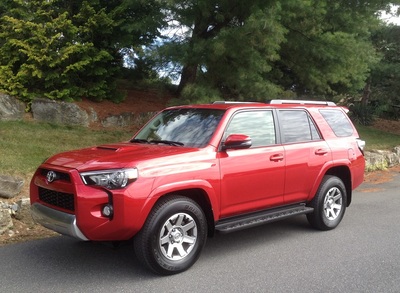2016 Toyota 4Runner Premium 4X4 Trail Review by John Heilig +VIDEO
By John Heilig
Senior Editor
Mid-Atlantic Bureau
The Auto Channel
REVIEWED MODEL: 2016 Toyota 4Runner Premium 4X4 Trail
ENGINE: 4.0-liter DOHC V-6
TRANSMISSION: 5-speed automatic
HORSEPOWER/TORQUE: 270 hp @ 5,500 rpm/278 lb.-ft. @ 4,400 rpm
WHEELBASE: 109.8 in.
LENGTH X WIDTH X HEIGHT: 191.3 x 75.8 x 71.5 in.
TIRES: P265/70R17
CARGO CAPACITY: 46.3/88.8 cu. ft. (rear seats up/down)
ECONOMY: 17 mpg city/21 mpg highway/19.1 mpg test
FUEL TANK: 23.0 gal.
CURB WEIFGHT: 4,750 lbs.
COMPETITIVE CLASS: Ford Explorer, Chevrolet Equinox, Nissan Pathfinder
STICKER: $41,690 (includes $900 delivery, $1,695 options)
BOTTOM LINE: The Toyota 4Runner offers a surprisingly smooth and quiet ride for what is a very good hauler.
Toyota promotes the 4Runner as “the go-to-SUV for Go-Anywhere capability.” This is true. The 4Runner, which has been around for three decades, not only looks the part, but it can do almost anything you ask of it.
Beneath the aggressive hood scoop is a 4.0-liter V6 that pumps out 270 horsepower and 278 lb.-ft. of torque, enough to tow a 5,000-pound trailer with a 470-pound tongue weight.
Handling is generally good, but it is compromised somewhat by a tall aspect ratio and ride height. Overall, however, ride quality is surprisingly good for what is essentially a truck. On decent roads, which are few and far between in Pennsylvania, it’s almost like riding in a luxury sedan with a long wheelbase and a heavy chassis.
Its full-time 4WD system uses a TORSEN center differential with a locking feature and a three-mode center console-mounted switch. The system uses a 40/60 torque split in most driving situations and alters that in response to slippage. If the front wheels are slipping while the vehicle is turning, the differential changes the split to 30/70. If the rear wheels are slipping while the vehicle is turning, the differential changes to a 53/47 split. That’s all courtesy of Toyota.
Again, according to Toyota because we drove it exclusively on-road, the Trail grade version can adapt the vehicle with the Multi-Terrain Select system. Using an overhead dial to select the mode that matches prevailing terrain and conditions, the 4Runner adjust wheel slip accordingly. Terrain choices include mud and sand, and moguls.
I was impressed by the 4Runner’s cargo carrying capability, since I had no opportunities for off-roading. First, with two-row seating (three rows are available) there are 47.2 cubic feet of cargo in back. Lower the second row seats (and the seat cushions must also be lowered into the footwells for a flat cargo floor) and you have nearly 90 cubic feet of capacity. In our tester, capacity was somewhat limited by the addition of an available pull-out cargo deck (a $350 option) that can carry up to 440 pounds to make loading and unloading easier. Slide the deck out to its maximum, load your suitcases or boxes on it, then slide it back without having to stretch deep into the cargo bay. You can also use the deck as a seating area or as a table for tailgating. The rear cargo area has multiple tie-downs and grocery bag hooks, as well as a 110-volt outlet.
We took neighbors to the airport and they were able to put their luggage easily in the back, then enjoyed a comfortable ride in the second row with more than adequate leg room. The second row seats have a pull-down armrest and feature 16 degrees of reclinability in four steps. Entering the rear is made easier with running boards on both sides. These are necessary because the 4Runner rides high. In addition, there are four assist handles, and the front passenger has an additional assist handle on the A-Pillar. Had we brought a third passenger, he or she could have ridden in comfort with a low rear center hump.
The front seats are comfortable with decent side support. They are well padded. The center console/arm rest is deep. At the base of the center stack are 12-volt, USB and AUX connections.
Exterior styling is dominated by that hood scoop and generous use of chrome plating on the bumpers, etc. The “manliness” or “truckness” is emphasized inside with control knobs that have a rugged style. This style is echoed in the speedometer and tachometer bezels. Other than that, it’s a fairly standard instrument panel and dash. I thought the digital clock that is located at the top of the dash was hard to read in daylight. Interior styling has soft surfaces throughout, even on the rear door trim.
The rear hatch is manually operated. While it’s heavy, it is well counterbalanced and uses good struts. Pulling it back down is tougher, however. The pull-down strap, to me, is located too far from the end of the hatch, where it would provide more leverage.
The full-size spare is mounted underneath the cargo area, outside.
Overall, the Toyota 4Runner is a rugged vehicle with off-road capability and the ability to carry four to five people in comfort with all their luggage and whatever else they might want to take with them on a trip.
The Most In-Depth Unbiased Independent Toyota Vehicle Shopper's Research - Anywhere!
(c) 2016 The Auto Page Syndicate



